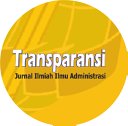Otomatisasi Interpretasi Data terhadap Bukti Perpajakan Digital
DOI:
https://doi.org/10.31334/transparansi.v3i1.753Keywords:
automation, interpretation, digital taxationAbstract
Model pengenalan secara otomatis terhadap bukti perpajakan digital dipandang sebagai salah satu mekanisme yang penting dalam organisasi untuk menentukan efektivitas dalam pengambilan keputusan dan pengendalian organisasi. Efektivitas ini dipengaruhi oleh kemampuan sistem dalam mengidentifikasi dan mengelompokkan data entitas. Kendala yang ditemui dalam pengenalan data terjadi karena kondisi fisik bukti perpajakan yang kurang baik, sehingga membutuhkan lebih banyak waktu dan berakibat kurangnya presisi terhadap interpretasi yang dihasilkan oleh sistem. Efektivitas kinerja sistem pengenalan ditingkatkan melalui penentuan langkah yang tepat dalam mengelompokkan entitas-entitas secara otomatis. Kemampuan otomatisasi ini melingkupi berbagai tahapan yang ada, yaitu dalam mengenali transaksi, mengekstraksi informasi di dalamnya dan mengelompokkannya dengan tepat. Penelitian ini menyajikan langkah-langkah yang dilakukan secara komputerisasi dalam bentuk model otomatisasi interpretasi data, baik dalam hal pengenalan transaksi, ekstraksi dan kemudian melakukan pengelompokkan terhadap entitas yang ditemui dalam bukti pemotongan PPh Pasal 23 secara digital. Langkah utama yang dilakukan dalam pencapaian tersebut melalui analisa dasar terhadap bukti berdasarkan interpretasi teks. Simulasi yang dilakukan terhadap beberapa bukti potong menunjukkan proses otomatisasi berpotensi meningkatkan efektivitas dan menekan kesalahan, bila dibandingkan dengan proses manual.References
Al Karaawy Najim Abd Aliwie, “The Impact of Making Tax Digital Application on The Accounting Costsâ€, Academy of Accounting and Financial Studies Journal, Volume 22, Issue 3, 2018.
Anggia Putri, 2019, “The Influence of International Tax Policy on The Indonesian Tax Lawâ€, Yuridika: Volume 35 No 2, May 2020.
C. K. Lee, S. Foo dan G. Goh, “On the Concept and Types of Knowledge,†Journal of Information & Knowledge Management, vol. 5, pp. 151-163, 2006.
Chandana Surabhi M, 2013, "Natural Language Processing Future", Proceedings of International Conference on Optical Imaging Sensor and Security, Coimbatore, Tamil Nadu, India, July 2-3, 2013.
F.Siasar djahantighi, M.Norouzifard, S.H.Davarpanah, M.H.Shenassa, 2008, “Using Natural Language Processing in Order to Create SQL Queriesâ€, Proceedings of the International Conference on Computer and Communication Engineering.
Gernot Kubin, “Stochastic versus deterministic concepts in adaptive systems designâ€, IEEE, 1988.
H. Sajady, M. Dastgir, H. Hashem Nejad, M. S., Juli / Desember 2008, “Evaluation Of The Effectiveness Of Accounting Information Systemsâ€, International Journal of Information Science and Technology, Volume 6.
Imran Sarwar Bajwa, M. Abbas Choudhary, 2006, "Natural Language Processing based automated system for UML diagrams generation", 18th National Computer Conference, Saudi Computer Society.
Irvan Iswandi, Iping Supriana Suwardi, “Otomatisasi Interpretasi Data dalam Sistem Informasi Akuntansiâ€, Seminar Nasional Informatika dan Aplikasinya (SNIA) 2013, Bandung, 18 Desember 2013
Kimin Seo, Jaemin Choi, Yong-seok Choi, Dong-chan Lee, Sangjin Lee, June 8-11, 2009, “Research about Extracting and Analyzing Accounting Data of Company to Detect Financial Fraudâ€, ISI 2009, Richardson, TX, USA
Lizhen Liu, Wandi Du, Hanshi Wang, Wei Song, “Automatic Summarization in Chinese Product Reviewsâ€, TELKOMNIKA, Vol.15, No.1, March 2017.
Mary Dee Harris, Ph.D, 1991, "Natural Language Interface to a Corporate Cash Management System", IEEE.
Mohd Azwan B. Mohamad, Abd Manan Ahmad, 2002, "Flight Schedule Query System Based on Natural Language Processing", Student Conference on Research and Development Proceedings, Shah Alam, Malaysia.
Metin Allahverdi, 2011, “A General Model of Accounting Information Systemsâ€, IEEE.
Nazarov M. A., “Digital Transformation of Tax Administrationâ€, ISCDTE, 2019.
Siamak Nejadhosseini Soudani, 2012, “The Usefulness of an Accounting Information System for Effective Organizational Performanceâ€, International Journal of Economics and Finance, Vol.4, No.5, May 2012.
Zsuzsanna Toth, 2012, “The Current Role Of Accounting Information Systemsâ€, Club of Economics in Miskolc, TMP Vol.8, Nr.1, pp.91-95.
Downloads
Published
Issue
Section
License

This work is licensed under a Creative Commons Attribution-ShareAlike 4.0 International License
Please find the rights and licenses in Transparansi : Jurnal Ilmiah Ilmu Administrasi By submitting the article/manuscript of the article, the author(s) agree with this policy. No specific document sign-off is required.
- License
The commercial use of the article will be governed by the Creative Commons Attribution license as currently displayed on Creative Commons Attribution-ShareAlike 4.0 International License.
2. Author(s)' Warranties
The author warrants that the article is original, written by stated author(s), has not been published before, contains no unlawful statements, does not infringe the rights of others, is subject to copyright that is vested exclusively in the author and free of any third party rights, and that any necessary written permissions to quote from other sources have been obtained by the author(s).
3. User Rights
Transparansi : Jurnal Ilmiah Ilmu Administrasi spirit is to disseminate articles published are as free as possible. Under the Creative Commons license, Transparansi : Jurnal Ilmiah Ilmu Administrasi permits users to copy, distribute, display, and perform the work for non-commercial purposes only. Users will also need to attribute authors and Transparansi : Jurnal Ilmiah Ilmu Administrasi on distributing works in the journal and other media of publications.
4. Co-Authorship
If the article was jointly prepared by more than one author, any authors submitting the manuscript warrants that he/she has been authorized by all co-authors to be agreed on this copyright and license notice (agreement) on their behalf, and agrees to inform his/her co-authors of the terms of this policy. Transparansi : Jurnal Ilmiah Ilmu Administrasi will not be held liable for anything that may arise due to the author(s) internal dispute. Transparansi : Jurnal Ilmiah Ilmu Administrasi will only communicate with the corresponding author.
5. Miscellaneous
Transparansi : Jurnal Ilmiah Ilmu Administrasi will publish the article (or have it published) in the journal if the article’s editorial process is successfully completed. Transparansi : Jurnal Ilmiah Ilmu Administrasi editors may modify the article to a style of punctuation, spelling, capitalization, referencing and usage that deems appropriate. The author acknowledges that the article may be published so that it will be publicly accessible and such access will be free of charge for the readers as mentioned in point 3.
Every accepted manuscript should be accompanied by "Copyright Transfer Agreement"prior to the article publication.











